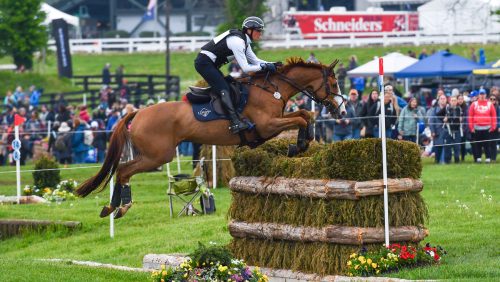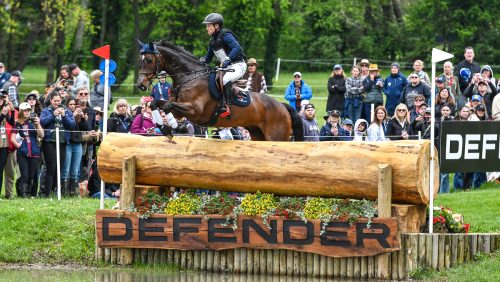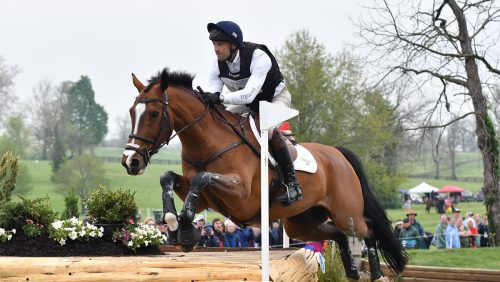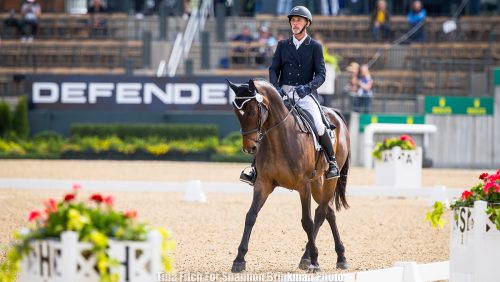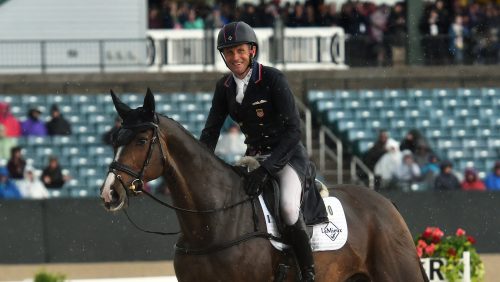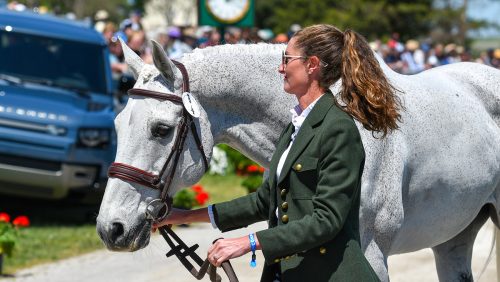Riley Kosirog laughed as she recalled her first recognized event with Johnie Bravo.
She and the 15-hand bay were approached by a woman who’d seen them in the dressage warm up and asked if “John” had been imported and if he was a German Riding Pony.
The woman must have only seen him from his right side, as John has a large brand covering his left hindquarter that reads “KAQ.”
“I couldn’t help but giggle because she was so far off track,” she said. “I turned him around and explained how he was a feral-born Navajo Nation pony I got for free in Arizona. I will forever laugh at the look of shock and confusion on her face as she learned my horse was ‘grade’ and a previously feral horse born out of an unmanaged herd.”
John is not Kosirog’s first Navajo horse. She got her first one, Lucky Ace Of Hearts, when she was 8 for $300 from a local horse trader near her home in Cave Creek, Arizona.
“Ace” went on to become the 2014 U.S. Eventing Association’s junior beginner novice horse of the year.
Kosirog moved on from Ace to her first big horse, an off-the-track Thoroughbred, and they were competing at novice until he died of colic when she was 17.
She met John while working at a dude ranch near her home. Her employer, Patty Motley, had purchased him after a round-up.
An estimated 40,000 horses roam free on Navajo Nation land, which occupies parts of northeastern Arizona, northwestern New Mexico and a small portion of Utah. Round-ups are one tool used to reduce the growing population, similar to what the Bureau of Land Management does to control mustang populations on its land.
ADVERTISEMENT
Motley had purchased six reservation horses of different ages and experience.
“She had gone up north to one of her friends that had let her know he had this herd of horses and if she wanted to come take her pick—they’re cheap, and they’re hardy and easy to feed,” Kosirog said. “It kind of works like the BLM mustangs. Some of these feral ponies are broke to ride; some of them are handled and end up being turned out because people can’t afford to feed them.”
John was nearly 2, kind of gangly, and had clearly never been touched.
“She told me they took a couple of these horses in a big old pen, and she saw him, and he was flying around, looking like he was barely touching the ground. He was feral and not handled at all,” she said.
When someone tried to put a halter on him, John struck out and broke the man’s foot, but they eventually got him on the trailer.
When Kosirog met John, she was a horseless high school student still reeling from the sudden loss of her Thoroughbred.
“I didn’t have a horse, and when I had a minute at work I just found myself sitting outside his pen, and we would just enjoy each other’s company,” she said. “He was friendly and curious enough to come over to me a couple times and sniff me and let me pet his nose and parts of his face, but you couldn’t do anything more than that. If you touched past his neck and shoulder he was like, ‘Hell no, see you later,’ and that was that for awhile.”
As time went on, John began to trust people more and became safer and more trustworthy himself. Kosirog helped with ground work whenever she had a few minutes.
When Kosirog graduated from high school, Motley gave her John as a gift. He’d been sent for 30 days of training, and Kosirog had him stay for another 30 days. When he came back, she rode him in a western saddle and used him as her wrangler pony, riding on trails four to five hours a day, always assuming he’d be a sales project.
ADVERTISEMENT
Eventually, she started putting a jumping saddle on.
“He’s super talented, a little watch-y, but that kind of goes with him being a Navajo pony,” she said. “They kind of don’t forget that ever. Even to this day, he’s 8 years old, and we’ve jumped novice and training cross-country jumps, [but] he won’t walk over a pole because it’s too scary and going to eat him or something like that.”
She started taking him to shows when he was 5. Kosirog said Navajo horses tend to grow until they’re 6 or 7 because they lack the proper nutrition in the wild, eating sage brush and weeds in the desert. John was about 13.3 hands when she met him and grew to 15 hands.
Kosirog enjoyed eventing and dressage for the past few years, but John gets a little nervous in show jumping, so she decided to stop eventing.
“Stadium was our hardest,” she said. “He’s a little more spooky, so he only felt confident if he’d done it three times before. Cross-country was always easy, and he’s always been super talented and uncomplicated on the flat. Those came easy to both of us. I was like, if he doesn’t love it, I’m not going to make him get back into it.”
For now, Kosirog, 21, and John are enjoying each other’s company on hours-long trail rides and competing in local shows, and Kosirog is hoping to do more dressage.
“I can’t tell you the last time I put an English saddle on him,” she said. “We’ve just been enjoying each other’s company. We’ll go out on these four- or five-hour jaunts in the national forest right by us.”
“This little horse has changed everything for me in training horses,” she added. “He is very particular, opinionated and has turned into an absolute ham who loves to be cuddled and loved on. He loves to smile and give kisses for a cookie. But he’s not without his quirks. Sometimes he looks at me sideways and acts like he’s never been caught before if I approach him the wrong way. Or seems to forget that he was indeed a show horse that has worn a blanket many, many times. He can be stand-offish with certain men, although never ever mean.”
Kosirog believes after the death of her Thoroughbred that John was meant to find his way to her.
“He is without a doubt my heart horse,” she said. “John is a great example of the things a grade horse can do, and I’ll always spread awareness about Navajo nation horses and ‘riding the brand.’ ”










